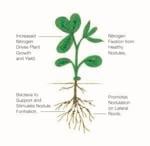From lab to harvest: The development and life of TerraMax’s microbial inoculants for soybeans
In ag-tech company TerraMax’s research lab, there is one prevailing question: How can you keep microbes alive to do their job and benefit farmers? In the past, microbes in inoculants didn’t survive longer than a few months. CEO and scientist Doug Kremer, who has worked with microbes for decades, saw this challenge as a puzzle to solve. “We had to make these things live longer in a jug,” he said. “At TerraMax, that became our focus.”
“Science is a method, and to make that method work we have to break things into pieces and study them,” Kremer said. “However, when you put things back together, you may not have your answers still in place. I looked at that and saw an opportunity to formulate organisms to keep them alive and tap into their abilities.”
The answer is TerraMax’s industry-first formula that keeps microbes alive and shelf-stable for up to two years. And, it’s not just corn that gets the attention. TerraMax’s line of products for soybeans fits into many farming practices, including their low-volume formula Maximize, and TerraMax Dry and TerraMax Liquid IF, both of which have passed rigorous testing by third-party company Beck’s Hybrids. Essentially, these products must demonstrate that they provide a positive yield increase over a three-year field testing period and average a positive return on investment for the farmer.
In the lab
Back in the lab, Director of Research Molly Tillman appreciates the Beck’s Practical Farm Research Proven stamp of approval, while continuing to focus on TerraMax’s research questions. “It’s very valuable data for us to have, because it was done by a third party,” Tillman said.
But her days aren’t just spent producing healthy colonies of the strains of Bradyrhizobium that make the soybean inoculants successful in the field. She’s constantly investigating how TerraMax products can perform even better. “We’re getting into the chemistry of how these microbes function in terms of nitrogen fixation — how can we quantify that in the lab? Which strains perform better? How can we get them to perform more nitrogen fixation?” Tillman said.
Currently, the two strains of Bradyrhizobium in TerraMax’s meticulously blended stabilization formula for soybeans assist with nitrogen fixation by increasing nodulation in the roots. Bradyrhizobium is carefully grown and nurtured in the sterile environment of the lab before being mixed into the correct formula to make TerraMax’s various soybean inoculants.
Microscopic mechanics in the soil
Once packaged, distributed and shipped, products remain shelf-stable for up to two years. When a farmer applies inoculant to their soybean seeds, they reap one of the first benefits of TerraMax products.
“Our process allows us to more effectively and efficiently make products and get it to our users,” Kremer said. “In our products, there are 400 units (a unit being what it takes to treat one pound of soy). Most others on the market had 1,800 units — that’s four times the amount of waste.”
For waste- and cost-conscious farmers, this is a distinct benefit. “It’s not just that we can get [the microbes] to survive better in tougher conditions, it has greater application capabilities,” Kremer said.
Bradyrhizobium remains stable on seed for 30 days with TerraMax Dry and up to 120 days with Maximize. When the seed germinates, the microbes provide a nutritional advantage. Soil contains diverse ecosystems, the interactions of which we’re only beginning to understand. According to research publication Frontiers in Plant Science, microbes in the soil biome free up nutrients like nitrogen, phosphorous and sulfur that are bound in organic molecules and therefore unavailable to plants. While plants lack the metabolic capabilities to make nutrients bioavailable, microbes do. The in-the-soil result is more robust root systems with increased nodulation.
Harvest and results
Soybean plants treated with TerraMax (right) have healthier root systems with increased nodulation. Photo provided by TerraMax
TerraMax microbial soybean inoculants reduce waste during the application process, increase nitrogen fixation within the plant, and facilitate healthier root systems and healthier, more biodiverse soils. The benefits are visible throughout the plant and the growing season. Field testing of Maximize demonstrated 3-5 bushels per acre more of soybeans than untreated plants. For TerraMax Liquid-IF, farmers can expect a demonstrated three-year average ROI of $13.07 on top of higher yields. In the Beck’s PFR 2018 study, TerraMax Liquid-IF was the only product out of four that were tested with a positive ROI.
In a market where few products are made specifically for soybeans, TerraMax stands out as a leader. Or as Beck’s Hybrid’s field agronomist Eric Wilson said after three years of testing, “other products tested were a mix of biological and fertilizer type products, while TerraMax Liquid-IF is formulated specifically for soybeans. We suspect [the two strains of Bradyrhizobium] provided a benefit above what natural populations could supply in terms of nitrogen and, in turn, translated into higher yields” (Beck’s PFR 2018, p. 52).
And for TerraMax, a research-based company, this applied precision science is part of the solution for America’s soybean farmers.

